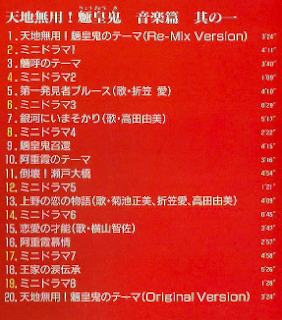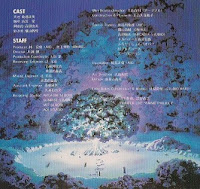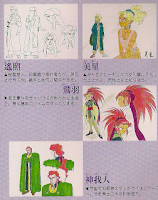Does this look like a Japanese import or an American product?
I am a huge fan of Namco's Soul series, specifically Soul Calibur II. Naturally, playing those games will open you up the audio. Junichi Nakatsuru did a epic score on that game. So recently, I decided to test his metal in his other works. Although, here he is just a guest composer. Offering only a few tracks per cd.
There is certainly a ton of material in this 4-disc set. I don't know where to start, so I'll go by composers. Our Music Producer is Keiki Koboyashi, whom has his takes on the Soul series. Tetsukazu Nakanishi serves as Sound Producer. Joining our lead composers is Hiroshi Okubo and of course, the reason why this review is possible, Junichi Nakatsuru. Takanori Goto performs the electric guitar on numerous pieces. Most of which are for Nakatsuru's tracks.
Starting with the top, Keiki Koboyashi, is the main cook in question. He offers us with some enjoyable appetizers, Briefing I and Hangar I. The precedent leads with some funky bass and anthemic brass. It can give the feeling of taking flight, before entering the actual game. Hangar is also just hip, in that it welcomes the player with warm feelings, just before they get shot down. Shorebirds takes charge with its cinematic opening. Open War is the more darker than the previous. Both feel like tutorial music, and thus accurately placed on the CD.
The real food is now served to us with Naval Blockade. Mature strings and brass fill the ears with delight. Amazing crash of the symbols and tense beats of the drums, make war seem like a good thing. First Flight is taken from Ace Combat 4 and rearranged here. Strings whistle at a high pitch, but I don't know if it does better than its electronic counterpart. Still, it does not hurt Koboyashi's lineup. Rendevous opens up with some tensity, gains even more with speed, and the additions of a somewhat electronic beat, for about a minute, until it loops again with more emotional string and brass. Lit Fuse comes in crashing with the symbols and snare drums. More strings are added and a nice touch of the triangle. After a minute of preparing orchestrations, Koboyashi takes flight with high pitched sweeping of the strings. He finishes his work on the first disc with Game Over.
On the 2nd disc, Koboyashi offers some emotional pieces, but not without the help of synthesizers in Ice Cage and White Noise. Both are beautiful and touching renditions of each other. The precedent is painfully sad(in a good way) with its electronic beats and riffs. While, the ladder is more mature in terms of instruments and orchestrations. White Noise is more reminiscent of some Hollywood movie scores. As this entire soundtrack is made with that in mind.
Light harps open up in Free Flight. Snare drums and violins follow in. Heavier drums, symbols, and brass take charge for this patriotic theme. Supercircus just satisfies my taste buds. Action orientated with Takanori's rocking guitar. Koboyashi's brass builds the intensity of the piece, making for a perfect combination. Into the Dusk falls more in line with Free Flight, but is a Waltz-esque approach. It slowly starts with brass and then piano. Key by key, note by note, Koboyashi touches the soul with this piano arrangement of the main theme. And then ending this disc with Final Options.
Coming back onto Disc 3, Keiki follows up with his first Briefing and Hangar themes. Though in the second Hanger begins more quietly, both are pure symphonic entree's. Hangar arrangements us familiar to Jurassic Parks theme. Wings of Unity has an interesting beat, excellent violins, string, and brass compilation. Its not very different from the rest of his work, yet he manages to make each piece unique and independent. If Supercircus were stripped of its guitar and fused with Lit Fuse and his hip Briefing I theme, Dead Ahead would be the result.
The Unsung War is the main dish. If all of the above was not good enough, well this one accumulates all that Mr. Koboyashi has done thus far into one grand course. Powerful vocals seer through the ear, into the brain, and touches the soul. This track alone made Mr. Keiki Kobayashi the star that he is. The Warsaw Philharmonic Orchestra performs both The Journey Home and Razgriz. Both feel like movie experiences. They are sweet and melodic. For me though, being true classical music, is not my favorite meal. Razgriz is like the 7 minute wonder, but without the lyrics.
Koboyashi only cooks a few short pieces for the Arcade version. Both Clear and Victory Road are pumping, but it's at the end of the day feel to it, that won't get it stuck in the head. This complete soundtrack has an amazing main theme, Razgriz, which should be listened to, from the get go.
From Razgriz and on, I assume, are all BGM's to the cut scenes. Open the War has some pace to it, but the rest are slow pieces, and they should be taken the time to listen to. However, other than the aforementioned piece, these short tracks are good to breeze through. 15 Years Ago is an excellent piano arrangement, that could get repeat plays. Blind Corridor is sleek and creepy. It stands out as one of my favorites for Keiki's last moments in this 4-disc collection. It does burst out in the middle and then at the end. Fugitive Hope also starts out quietly, but gets down and dirty for whole entirity of it. There is surprisingly just as much tension and percussion in these last tracks as in the in-gameplay music.
Mary Elizabeth McGlynn adds her voice to The Journey Home, this game's ending theme. The lyrics are precise, and she hits the notes accordingly, but the song doesn't reach to me. I'm more attracted to the radio version, vocalised by Elizabeth Ladizinsky. It is uniquely engineered to start out as if it's coming from the radio back in WWII. Then gradually evolving into our modern day quality sound. Interestingly, and oddly, Puddle of Mudd's Blurry has been included. Never liked the song, but I guess its a nice add. Nakatsuru finally does a song, well, at least a remix of Blue Skies. Originally done by Hiroshi Okubo, and appearing on the two preceeding OST releases. I did not like it at first, for it's jazzy tunes, but after a couple tries, Nakatsuru regains my respect. Some composers can't do songs as well as instrumentals.
Speaking of Okubo, he contributes a few main game pieces and most of the arcade themes. All his arcade themes are hip, funky, rocking, and the antithesis of the main game tracks. I'm kind of weary of the decision that King Records has made to put these fun tracks in together with Koboyashi's more serious cut scene music. Although, they probably had no better way to do it. Okubo's arcade themes, are not grand, but can be catchy and have the audience dancing. They are all equally addicting, with Elemental Particle 2 giving the most jolt of electricity. Although, he uses only instruments that a band would use, but that's what appeals to me most anyway.
Given that only three console tracks were composed by Okubo, I would that is enough. I keep thinking that it's game over when White Bird I opens up. I do like the whole track, and the use of more traditional instruments. Hiroshi certainly stands out from the rest of the crews style, but thats not so much a good thing. For now, his work can belong with the entirity of the disc.
Way over on Disc-3, is White Bird II, which has even more electronic sounds filling in with his anthemic score. He does get a little emotional in the later half of the track, eventually making a solid effort. It's atmospheric synths are not too far from Metroid Prime's score. Heartbreak One takes drums kits and more electonic noises that will throw of any stereo system. Which is normal for anyone who gets this type of music.
Entirely new to me is Tetsukazu Nakanishi, who owns the first track, Title. It took some to get used to, but Nakanishi has opened my ears even more. He commands all of the enemy themes, which give off the more brash and clash then Kobayashi's themes. In Wardog, its does not stray far from the music director's style. Being one of the longer tracks on the first disc, it feels right at home as a tutorial theme. Very welcoming and enjoyable. I think he does better than Kobayashi. Though, Tetsukazu lags behind in menu themes, for being less orchestral and more purely sounds.
Ballistic Missile and Demons of Razgriz immediately gets into Ace Combats shady side, as well as the rest he offers. Scinfaxi picks up the pace with more percussion. Hrimfaxi is the same but adds Goto's electric guitar skills. All 4 pieces use sounds that would be found on the vessels used in the game, giving more depth and immersion into the setting. I criticize those for being a little too similar, although they are still each unique.
Powder Keg and Front Line are more active and dark, really getting into the intense wars. Nakanishi is not hesitant to use Goto in the latter. Front Line is very attractive with strong drums and guitar works, for great action music. Though, Desert Lightning gets even more gritter. The entire piece is filled with dark chords of brass and the Devils Chord, I believe. Takanori enhances the darkness with his talent.
Desert Arrow has that fantasy element and emotional symphony sound that is being drawn from Hollywood. Some nice percussion leading to a nice peak at 2:30. Fortress takes a different route, mostly consisting of strings and brass. The percussion enters around halfway, and things get more interesting. Ancient Walls is not too different from the previous. Not too attractive beginning, but after a minute or so, it grew on me. The extra jingles made the difference.
The one characteristic about Nakanishi's style is his beat, its what sucks me in. And his menu themes hold true to that, but lack any true reason to come back to them. Solitaire and Closure are both fun tracks to listen to. Solitaire has evil brass and a funky jungle beat. Closure is just as the name suggests, with a strong beat, emotional brass, and intricately written piano arrangement. Mr. Nakanishi finishes off strong, as I barely got introduced to him.
I've saved the best for last, Mr. Junichi Nakatsuru. Not one of his tracks disappoint. In my opinion, I question the importance of having the other composers. Junichi shows more love for instruments than anyone else. Takanori Goto would have been sitting out, what with the one or two tracks that he has been slipped into by Koboyashi and Nakanishi.
Ghost of Razgriz rips through air with Takanori's guitar. The same air sounds are used in Grabacr. Climatic from the begining, and soon adding more drama with a strong female vocal. Winter Storm really takes the listener into the mountains for a hike. Mask and 8492 is similar to the previous, but Nakatsuru knows how make it a worth while listen. Chained Reaction's brass carries through as if truly racing against the clock. All have some sort of dark piano keys imbedded between all the drama.
Four Horsemen is one of the more attractive offerings that Nakatsuru-san has, and it's certainly the more brighter ones. Hints of espionage acoustics, funky bass and electric guitar. From start to finish, and the middle interlude with the brass, just make the earbuds melt in. Reprisal is a five minute glory, that encapsulates all of Hollywoods grand themes into one track. Takanori's guitar skills work symbiotically with Nakatusuru's brass. The final minute's tearing oboe bring aesthetics back to music.
Blind Spot is surprisingly quiet, that is more heavy on electronic and computer synths. Mother Goose I is the most relative and effective track in Ace Combats line up. The entire track is a journey, changes landscapes between each minute. Opening up with electronic synth the first, getting ready for take off, and then quiets down for landing. Picking back up for an extreme and hostile situation, with heavy drums, strings, and brass. Pure brilliance.
http://www.squareenixmusic.com/features/liners/acecombat5.shtml
Above is a link to the composers commentary. Nakanishi doesn't have much to say, or rather, want to say. He's probably mad that he lost the director's position. They all have some sort of enthusiasm toward the project. Though, I find it weird to hear of Nakatsuru's cats and dogs. Junichi points out correctly, that each composer's style had a chance to shine.
Namco always manages to package their discs well. Completely the opposite of Nintendo. Just the four disc compilation is enough to dish out $50. The booklet is just as hard as the case. Flipping through the pages is a cinch, and no need to bend the book. Texts, color, and layout are all done just right. Commentary is the only extra, if that counts as any. They could have at least had English translations.
Package: 8/10
Yes, I made the right choice to buy this CD and venture out from my little circle of composers. Each one here has a happy home on my hard drive. It took me a year to accustomed to their work. There is not one composer that I cannot prefer over the other here. Having not played the game, I don't see any track here that does not work outside the game. Although there are some tracks that are passable and filler, but there are plenty to keep busy with and most likely repeat over and over.
There is no reason to miss out on this compilations, and at a fair price. Original prints are still available just about everywhere. http://www.cdjapan.co.jp/ is filled with tons of them. I am a proud owner of this CD and the successors as well, with reviews coming up eventually. Though I need to try and get the previous.
Album: A+






















